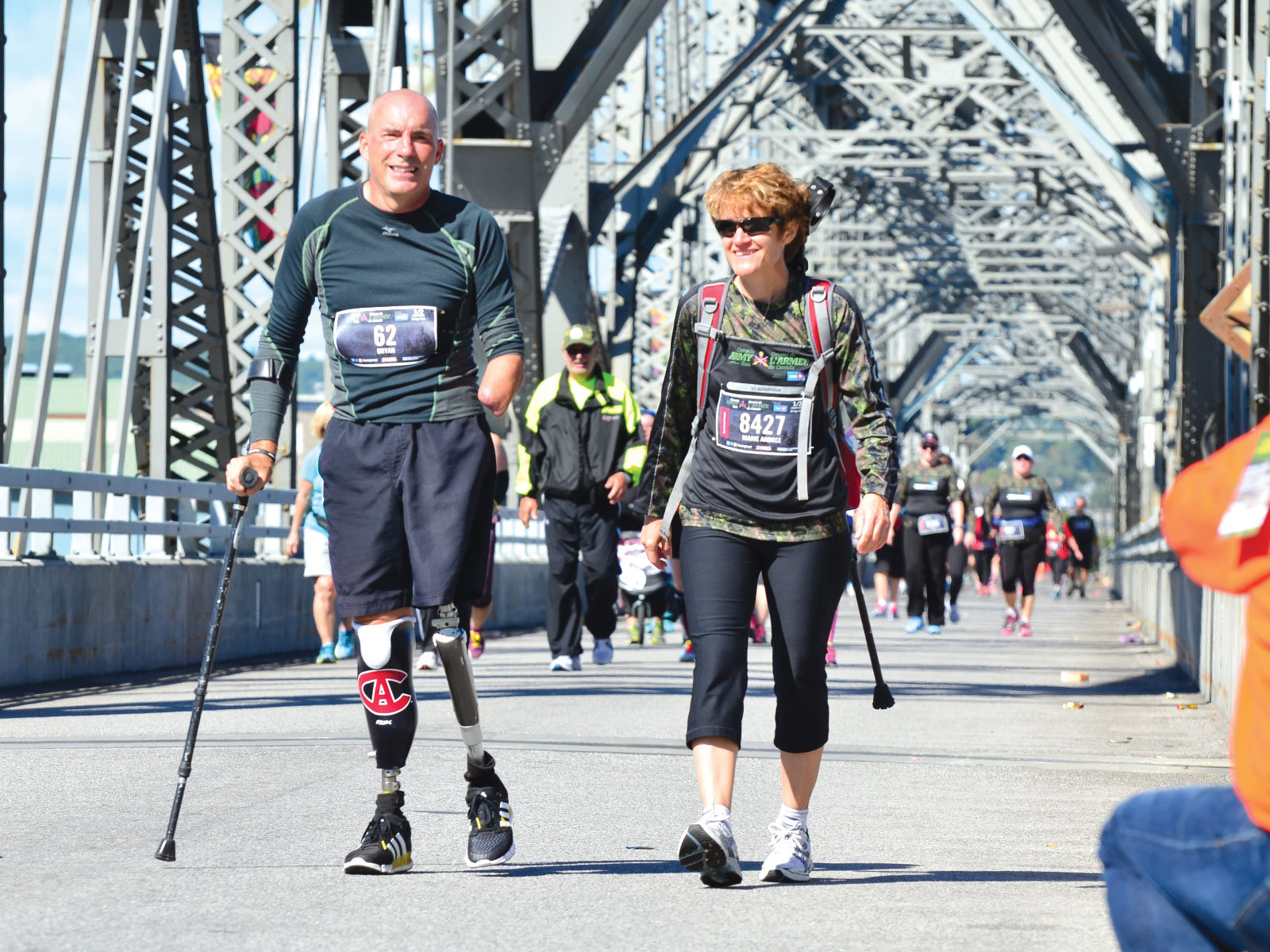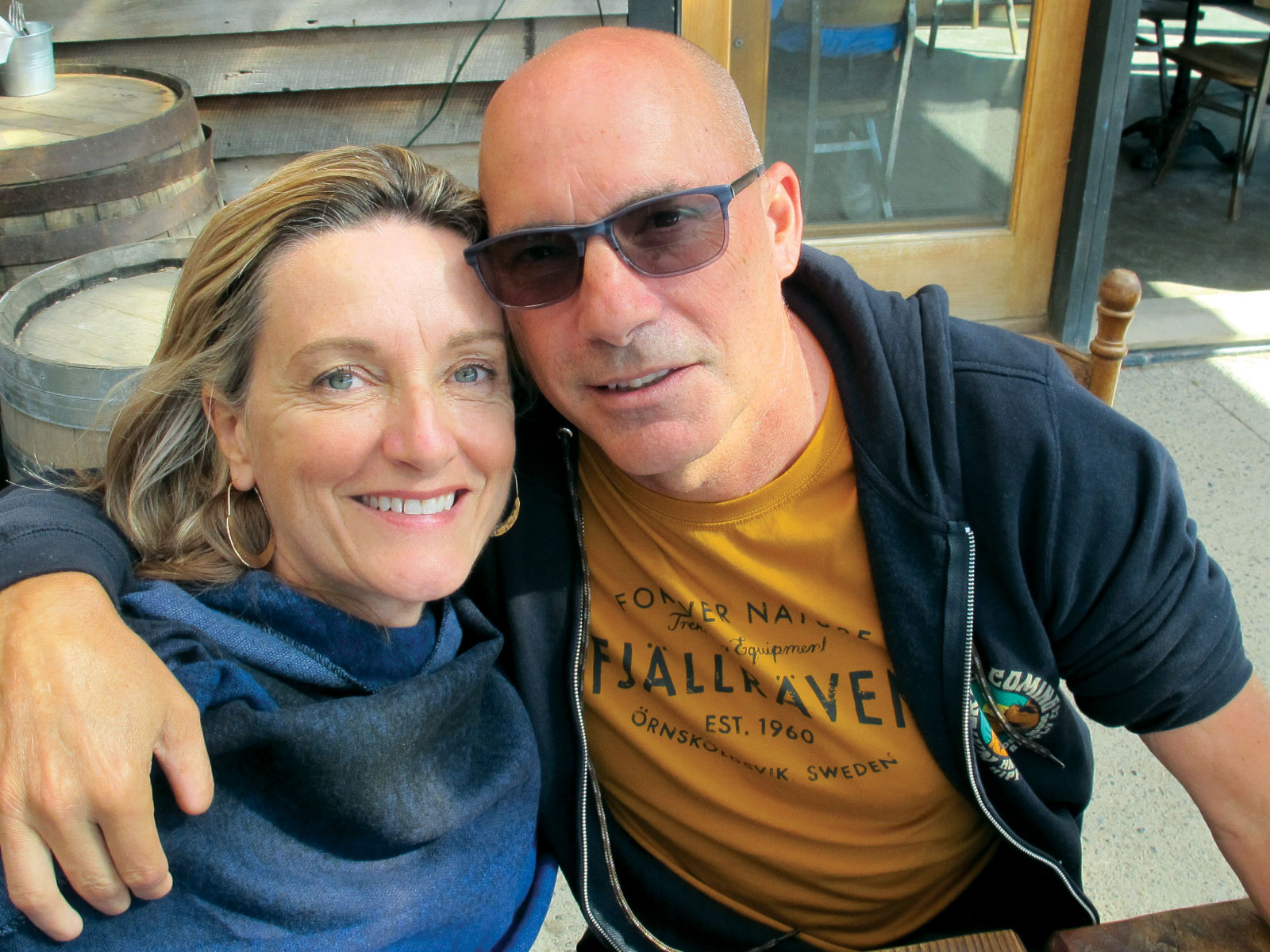By Kevin Spurgaitis
When Bryan Cuerrier went for a weekend jog with his girlfriend—and now wife—Marijo in May 2010, he had no way of knowing that it would be his last ablebodied run. That month, Cuerrier developed a pain in his leg, mild flu-like symptoms, and to everyone’s surprise, failed to show up to work. A few hours later, when Bryan was discovered by a neighbor who had been dispatched to check on him, his lips and fingertips on both of his hands were bluish in colour, and he was completely delirious.
Cuerrier was quickly diagnosed with group A Streptococcus (strep A) bacteria, which can lead to what is commonly known as flesh-eating disease. For more than a month, he fought for his life in Kingston General Hospital’s intensive care unit (ICU). Surgeons were forced to amputate his left leg from the hip— referred to as a hip disarticulation—to remove the dead tissue caused by the infection. As flesh-eating disease continued to ravage his body, serious circulatory problems also led to the loss of his left arm below the elbow, his right leg below the knee and his fingertips on his right hand.
Several months of intensive rehabilitation at Ottawa Hospital Rehabilitation Centre helped Bryan learn to walk again using prosthetics which he continues to use today along with custom made crutches. He also has several electric wheelchairs, a small one to get around his universally-designed home, and a larger one for out in the community.
According to Cuerrier, now 62, “I can do most day-to-day tasks on my own, but I also have a wonderful partner … who fills in where I cannot, and a strong family and [circle] of friends.” Stories like Bryan’s appear in news headlines from time to time, gaining considerable attention and raising a whole host of concerned questions, but for the most part, Canadians remain in the dark about what flesh-eating disease is, how a person contracts it, and whether or not they need to be more cognizant of its causes. The short answer is that they should be.
Flesh-eating disease, or necrotizing fasciitis, is an aggressive bacterial infection that decreases the blood supply to the tissues and damages or kills, soft tissue. It spreads rapidly through layers of skin and muscle—sometimes, in a matter of hours—and is life-threatening. The reduced blood supply blocks the transport of antibiotics to the infected site so, quite often, amputation to remove dead tissue and prevent further infection is the only path to saving a patient.
Various types of bacteria can cause flesh-eating bacteria. The two most common are Group A streptococcus and vibrio.
Necrotizing fasciitis is caused by an infection from a variety of bacteria, including strep A—the same bacteria that brings about strep throat. Found on the throat, nose and skin of healthy people, strep A is a family of bacteria that seldom causes any threat of illness at all. Still, the bacteria is somewhat of a medical mystery, as it can sometimes cause invasive infections, like sepsis and necrotizing fasciitis. The most severe strep infections in Canada are caused by a strain called emm1.
In July 2015, scientists at Imperial College London discovered a new variant, called emm89. It makes up only 10 to 20 per cent of the most serious infections. However, there’s no evidence that this new subtype—distinguished by toxin production and a loss of its outer capsule—will cause even more invasive illnesses. Still, the discovery warrants our attention, according to Dr. Liane Macdonald, a physician in communicable disease prevention with Public Health Ontario. Macdonald told CTVnews.ca that the discovery of the new variant of emm89 is “of interest” and definitely “new information to monitor.”
Very few people who come into contact with strep A will actually develop flesh-eating disease. But each year, there are between 90 and 200 cases of flesh-eating disease across the country, according to Health Canada. And, unfortunately, approximately 20 to 30 per cent of these cases lead to death.
It is a disease that sometimes comes in clusters, and some of those waves can be serious. An outbreak in London, Ontario in April 2016 affected 132 people, killing nine. In fact, the number of serious invasive infections has increased in Canada in the past two decades, according to the Public Health Agency of Canada. They’re up from an estimated three cases per 100,000 people in 2000 to about four cases per 100,000 in 2009.
Meanwhile, between 700 and 1,200 cases are diagnosed every year in the US, according to the Centers for Disease Control and Prevention (CDC). And similarly, about 25 to 30 per cent of all US cases result in death. But it’s not known why cases have risen, nor why the bacteria causes flesh-eating disease in some cases and not in others.

In April 2019, Harry Sandhu developed the bacteria after someone hit his shin during a soccer game, according to the Vancouver Sun. The 43-year-old Victoria, BC man experienced a swollen shin and projectile vomiting before being diagnosed.
At the beginning of 2019, Anik Cormier lost consciousness— and her upper lip—after she contracted flesh-eating disease on Christmas Day. Although the 40-year-old, from Legal, Alta., told the CBC that she didn’t feel ill at all, her face and neck were swollen, which prompted her to go to University of Alberta Hospital. Surgeons there had to remove her top lip, along with a part of the cheek on the right side of her face. They then gave her a skin graft, repairing her lip by using skin from her leg. To survive the ordeal, Cormier was sedated and had to breathe through a tube for several weeks.
There are other stories of people who have been touched by the mysterious flesh-eating disease. But patients have had varying degrees of fortune.
In June 2020, CTV News reported that a Montreal patient with flesh-eating disease was saved thanks to a rather unique treatment. A Gatineau firefighter was treated at McGill University Health Centre (MUHC), where doctors used a technique known as extracorporeal membrane oxygenation (ECMO). It involved an ECMO machine, a type of respirator that the hospital typically reserves for those with COVID-19. Essentially, the respirator controlled the patient’s heart and lung functions for two weeks.
“When he arrived from the Montreal General Hospital, he was in profound shock and with minimal signs of functioning organs at the time, and required urgent care,” said Dr. Gordon Samoukovic, a critical care physician at MUHC. “The odds of survival with everything we could have done at that time were miniscule.”
However, other Canadians haven’t been so lucky. In August 2012, Corey Witkowski succumbed to the disease in Burlington, Ont., according to the Toronto Star. It is not known how the deadly bacteria invaded Witkowski’s body, but the 42-year-old developed a fever and vomited for several days before waking up one night with severe back pain. In Joseph Brant Hospital’s ICU, tests revealed that the source of his back pain was necrotizing fasciitis. Later, Witkowski’s vital systems and organs completely failed him.
“Corey had suffered from a very bad case of eczema for most of his adult life, and he brushed off the pain and the wound as being one of his sore spots from his eczema,” Witkowski’s friend, Derek Boyce, told the Toronto Star. “The entire staff of the intensive care unit were nothing short of amazing during Corey’s short stay. They did everything they could to keep Corey alive for Amanda (his wife) and the girls, but ultimately this rare disease could not be defeated.”
Antibiotics and surgery are the first line of defence if someone has contracted the disease. Roughly one in three die from the infection.
Following the birth of her second child, Belle River, Ont. resident Stacey Harris also developed flesh-eating disease before dying in May 2015. Harris was 30 years old. She was first transferred from a hospital in Windsor, Ont. to London Health Sciences Centre (LHSC), where she was placed in a critical-care ward, according to the Windsor Star.
In the US, cases of flesh-eating disease are no less severe. A Florida woman who cut her leg on a beach died from the bacteria in July 2019. Carolyn Fleming developed the small cut and bled continuously after stumbling near her home in Ellenton, FL., according to the Associated Press (AP). The 77-year-old was later diagnosed with the disease, which led to two strokes, kidney failure and eventually, her death.
On another Florida beach that same year, a 12-year-old Indiana girl contracted the flesh-eating bacteria after scraping her toe. Because the bacteria can live in salty water, it’s often found in southern US cities, according to AP.
Given that a benign cut or bruise can rapidly progress into a far more serious—and potentially fatal—infection, early recognition of flesh-eating disease symptoms is critical. So is early treatment.
If an injury or wound is evident, the tenderness and redness around a wound can spread quickly. This discolouration can then change to a reddish-purple colour and be accompanied by blisters and bullae—or fluid-filled pockets. Other flesh-eating disease warning signs are typical flu symptoms: fever, raised heart rate, and a feeling of malaise, as well as significant, rapidly-increasing pain. The latter can be disproportionate to the type or size of the injury.
Once more, flesh-eating disease is quite rare—the chance of contracting it is rather low. Nevertheless, given the rapidity and high mortality linked to the bacteria, it is important to lower the potential risks by immediately treating wounds. Health Canada advises people to take care of cuts and wounds, however minor, by washing them with warm water and watching for signs of spreading infection; keep cuts dry with bandages; and consult with a family doctor, who can prescribe antibiotics as a precautionary measure. And, naturally, they should seek immediate medical attention if they experience any symptoms associated with flesh-eating disease.
Other risk factors for developing the disease include close contact with someone with flesh-eating disease and a weakened immune system due to HIV/AIDS, diabetes, alcoholism, intravenous drug use, or even anti-inflammatory or cancer medications.
With a quick diagnosis, rapid treatment and fast surgery, flesh-eating bacteria does not have to be fatal. The trick is to get immediate help.
Although Bryan Cuerrier lost both of his legs and a part of his left arm to the strep A bacteria, he still participated in Ottawa’s Canada Army Run in Ottawa—a half-marathon (21.1 kilometres)— in September 2015. And although he was the last of 25,000 participants to finish, he was one of the first triple amputees to complete the marathon. At the finish line, he was surrounded by his wife Marijo, his family and friends, his medical specialists and a Canadian solider who placed a medal around his neck. The Canada Army Run was not only a major focus of his recovery, it symbolized his effort to reclaim a part of his life, he said.
Despite his own physical restrictions and challenges—or perhaps because of them—Cuerrier continues to encourage other people with disabilities to “give life their best shot,” too.
“Don’t dwell too much on what you cannot do anymore. Just concentrate on other things that you’re able to do. Going forward, you have to decide for yourself what those things are and figure out how to get through [life] … You really have to learn to adapt.”
As Cuerrier explains it, he’s not better or worse off than the average Canadian. He’s been given a day at a time with which to do what he wishes. Sometimes, he’s“productive,” while other times, he’s “at a loss for what to do with the day” that he has been given.
“Someone once said to me, ‘You are the poor fellow that got flesh-eating disease,’ and I replied, ‘No, I am the lucky fellow that got flesh-eating disease’,” Cuerrier says. “I try to remember each day that had I not made it through the events of May 2010, I would not be here to enjoy the day in front of me. And that would make me poor. But I am here, living, breathing, and being loved and loving back. That makes me lucky.”
Kevin Spurgaitis is a Toronto-based writer interested in ethics and public health issues.














